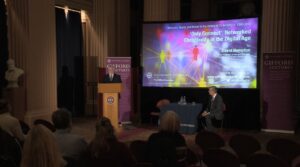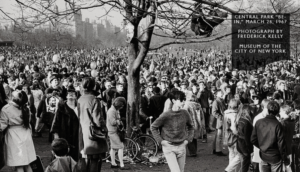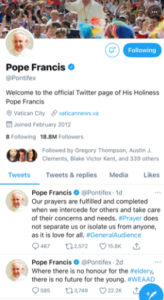Gifford Lecture 6- “Only Connect!”: Christianity in the Digital Age
Professor Hempton greeted us into his last lecture by thanking the University of Edinburgh for their great hospitality and thanking the blog respondents for meeting him for coffee al fresco. His stimulating and energetic lecture however soon warmed up the Playfair library. As usual, below is a short lecture summary, followed by a response by PhD Candidate in World Christianity Agana-Nsiire Agana, ending with our last lecture video.
Professor Hempton returns to a book explored in his first lecture, Niall Ferguson’s The Square and the Tower, which he begins with the print revolution and ends with the internet and social media phenomenon in our current day. Ferguson talks about how the smartphone has increased inequality and instead of disrupting religion, it has disrupted commerce at greater rates. He only pinpoints Islam as a religion disrupted by the digital, discussing Jihadist networks constructed by Islamic extremists. Hempton however questions the idea that Christianity has not been affected, and instead wonders if it has been/will be fundamentally reshaped by the digital revolution.
Recognizing the scale of analysis for the digital when compared to the print revolution is much reduced, because we are currently living through this revolution, Hempton focuses on three key questions for this lecture: what social changes were already apparent that enabled the rise of the digital revolution, what impact do these new technologies have on our lived religion and organized religious institutions and finally, to what extent has the internet helped developed global religious networks where power is not only transferred North to South but in a reverse trajectory too?
To answer the first question, Hempton explores the growing literature around secularization (or dechristianization), the important moment for which was the 1960’s. Pointing towards a previously edited book with Hugh McLeod, Hempton argues that the decades before the influx of social media and the internet, cultural changes had already undermined generational transmission of religion. The internet has allowed for ‘networked individualism’ has been a great tool for aiding the individualized identity theory developed in the 60’s.
This individualism has created more ‘fractured networks.’ Heidi Campbell’s in-depth analysis of three online religious communities, the Community of Prophecy, the Online Church, and the Anglican Communion Online, identified six attributes searches for looking for in these online spaces: relationship, care, value, connection, intimate communication, and shared faith. These are not necessarily different to in-person communities, comments Hempton, but ‘the online version confers more individual control, fewer geographical or temporal limitations, and more scope for individual spiritual experimentation and self-actualization’ and many people saw them as supplementary rather than their core community. Questions such as security and discipline, right teaching and the potential ability for selective tribalism also feature in the discussion of the pros and cons of religious networks online.

Some ministries also fair better online than others. The Billy Graham Evangelistic Association for example has found the internet to be a great tool for conversion, whereas an app developed for Catholic penitents was not seen by the Vatican as a sufficient replacement for the embodied act of confession conducted by a priest. Though the Roman Catholic Church is at the forefront of using social media. It was the first to have a website in 1996, created a Youtube channel in 2009 and has Twitter and Facebook. Campbell has shown that a new category of Religious Digital Creatives have emerged who’s authority is based on their digital expertise rather than their pastoral or theological credentials. The Covid-19 pandemic has only accelerated the speed at which we accept church online and there are questions about its future replacement of in person communities. Though, Hempton reminds the audience that a similar fear about e-books was present a decade ago but bookstores and physicals sales are steady.

The digital age is also proving to be a useful platform for the ‘nones’ or the ‘spiritual but not religious’ types. Two graduate students from Harvard Divinity School, Angie Thurston and Casper ter Kuile, explored the new hosts of organizations (generally middle class, white, affluent) millennials are joining- such as crossfit. They found that these places shared values with traditional religion such as community, personal transformation, social transformation, purpose finding, creativity and accountability. Another example is a group meeting to discuss the spirituality of Harry Potter books, perhaps a venture we are all too familiar with from the tours in Edinburgh mistaking John Knox for Dumbledore. It seems on one hand digital media can be used a tool for pre-existing institutional religion, and it can also work against this by promoting choice, and individualization, fluidity, and an overt link with contemporary culture.
Christerson and Flory bleakly argue that traditional denominational Christianity in the United States is in terminal decline because of the current challenges of globalization, the digital revolution and anti-institutional ideas. They instead foresee the future belonging to ‘networks of independent churches that emphasize direct supernatural engagement, innovative financial and marketing strategies and new digital communications.’ Christerson and Flory have observed the Independent Network Charismatic (INC) Christianity networks and found that their decision to formulate themselves as independent networks allows them to reach the ‘consumer’ without the bureaucratic procedures prevalent in larger bodies. Creating a ‘pay for service’ model, the majority of their income comes form books, music DvDs and web content, media sales, tuition, and conferences rather than congregational donations. The internet is also the delivery platform, rather than a traditional congregation and building, allowing the model to expand to meet the consumer. The model however has been hit by scandals, failed prophecies and a majority male prophetic base.
Though, of course, the digital revolution is not just a Western phenomenon. With at least 60% of today’s Christians located in the Global South, it is imperative to study how the digital world is affecting religion in the Majority World. Kate Bowler has explored how the power of social media has ‘accelerated’ the spread of the prosperity gospel into a global reality. A big vehicle for this kind of belief is the Mega Churches, beginning as an Anglo-American model but now being re-exported back to the West after indigenization in the Global South, with deliberate missional strategies of church planting. The main growth hubs are cities in Sub-Saharan Africa, Latin America, the Philippines and South Korea, home of the world’s largest church. These mega churches are supported by social media, television, radio, websites and music. Two incredible examples, both in Lagos, Nigeria are the Redeemed Christian Church of God (which also has the largest single congregation in Western Europe, the Kingsway International Center in London), and Winner’s Chapel, with their Redempton Camp and Canaanland ‘having the facilities of a small town.’
The African church diaspora in Europe and North America, according to Hempton, is made up of three strands, ‘branches of churches with mother church headquarters in Africa; churches formed directly by African migrants themselves; and third, ‘a proliferation of para-churches, prayer/fellowship groups and supportive or interdenominational ministries.’ And they are often found at nodal point of migration networks and consciously exploit technologies for their missions. The expansion from African inspired inter-personal connections to employing Western models of mass communication for evangelism can create tensions between churches with different cultural roots- Afro-Caribbean, African American or African. Nevertheless, the influence of these churches in the West is evident with the Council of Christian Churches with an African Approach in Europe (CCCAAE) and the Scottish Council of African Churches (SCOAC) being set up, alongside organizations such as Churches Together in England (formally the British Council of Churches) now having 52 member churches, more and more being African or Pentecostal, leaving the traditional denominations (generally the Free Churches) with less influence in the ecumenical scene they once controlled.
Another important network to notice is that of music, most significantly, Hillsong Praise Music from Sydney, Australia’s largest independent, charismatic, megachurch. Jeaney Yip, a marketing expert, comments how Hillsong have ‘de-religionized’ organized religion into a spiritual branded product. Hempton reflects on how the ‘worldwide dissemination of Hillsong praise music is somewhat reminiscent of the importance of Wesleyan hymns in the Evangelical Revival, but there are also some important differences.’ The network for the Wesley brothers was more limited to Methodists, and although personal pronouns and emotional connection was a key element, the music also went through ruthless theological editorial processes, even giving instructions on how to reduce the risk of emotional self-indulgence. Hillsong however seems to proudly be a brand, product and experience ‘indelibly marked by the cultural forces shaping it, namely, international corporate capitalism, experiential and therapeutic religion, transnational religious networks, the megachurch phenomenon, consumerist culture, and fast-moving technological changes in communications.’ The role of international corporate capitalism can also go beyond influence, with Facebook actively trying to use their platform for religious connectivity. ‘The problem is that it is hard to know whether the beneficiaries will be known as customers, consumers, or congregants, or if it even makes much difference.’
Considering the work of Joseph Henrich, an evolutionary biologist at Harvard, and his book ‘The WEIRDest People in the World’ that argues for the central importance of the Lutheran preformation and the creation of print culture for the particular cultural and psychological characteristics of the West. Henrich argues that one cannot separate culture from psychology or psychology from biology because culture physically rewires our brains and thereby shapes how we think, which in turn reshapes culture Hempton wonders how the digital revolutions will also change our cognitive abilities, our culture, and our religious traditions. Global capitalism and the financial market perhaps cannot be disconnected form the digital revolution, with Hempton wondering how the constant search for growth and opportunity, increasing the risk of corruption and capitulation, will allow organized religion to flourish.
Hempton concludes this lecture with two provisional perspectives for the future. The first comes from the reflection of some theologians in the zoom era, who are compelled to rethink church not as an institution with buildings and hierarchical orders, but of egalitarian and almost invisible communities connected by a desire for community even when bodies are not physically present. A second comes from the Empathy Diaries by Sherry Turkle, the Director of the MIT Initiative on Technology and Self. Her vision of the digital era is much more dystopian. ‘When we are online,’ she writes, ‘and when we are tracked by our devices our lives are bought and sold in bits and pieces to the highest bidder and for any purpose. … The social-media business model evolved to sell our privacy in ways that fracture both our intimacy and our democracy.’ One might add that it has the capacity to fracture our empathy and our spirituality. Time will tell.’
Response
Only Connect, But to What?
Listening to Prof. David Hempton’s lecture on Christian networks in the digital age has been a refreshing and inspiring experience. His lecture series spans the year 1500 to 2020, and it is astounding to think that the last twenty of those years are so important as to merit an entire lecture. As it turns out, that suits me well. My PhD research offers a theological critique of personal identity in digital culture. It combines secondary research with an ethnographic perspective drawn from digitally active Christian youth in Ghana. Like Hempton’s lecture, it takes a long view of the cultural impact of informational culture, specifically invoking a Kierkegaardian perspective developed in the technological upheavals of the Danish Golden Age in the nineteenth-century. I will thus be drawing from these perspectives on this evolution to offer a few comments on a very contemporary lecture.
Kierkegaard was skeptical about the impact of technology on culture. He saw the “outer life of telegrams and anger,” as the chief danger posed by information technological culture. [1] Within this culture, he feared that individuality would be lost in the superficiality of public Christianity. By eroding authentic personal faith in the individual, then, the technologically mediated society could not sustain any true notion of Christian community. The networks crumble. Were Kierkegaard at last night’s lecture, I believe he would have smiled at several points, but perhaps also shifted in his seat a lot. He would have nodded vigorously, I suspect, at Hempton’s observation that digital networks multiply the individuals’ alternatives for identity construction, but he would not have expected this to mean—rather ironically as Hempton notes—that this would facilitate the tribal grounding of individual identity so quickly. It would not have mattered much though, for his contention would remain that Christian networks were still jeopardized if the nodes and nuclei formed around worldly interests more than divine inspiration. Digital culture, with its endless gossip, boasting, self-help, motivational content, trolling, selfie culture, anonymity, and identity voyeurism, represents a constant displacement of the nuclei of Christian networks.
At the same time, Hempton notes how social media valorizes the individual to such an extent that the individual becomes pivotal in the restructuring of networks. What appears to be happening, then, is the emergence of a cultural mosaic in which technology simultaneously intensifies the strength of Christianity’s networks and erodes the strength of individual commitments so that with time, the nodes and networks formed must and are being redefined. Perhaps this is what we see observe in the fact that the search for meaning, intimacy, and self-improvement is shifting towards non-church groups such as Harry Potter and the Sacred Text and others. Perhaps church is being redefined in such a way that we may need to reconsider what constitutes a Christian node in a digitally pluralized online world. (It might interest seekers that EdinBurrow, an Edinburgh instantiation inspired by this, is co-organized by a current PhD student at New College, Jo Thor.)
Of course, this speaks immediately to the question of authority that Hempton raises. The standard predictions have been that digital culture disintegrates centralized authority structures and redistributes them according to interests and expertise at the individual level—the social media expert becomes the de-facto missionary, priest, and theologian. Here, Kierkegaard would truly be scratching his chin. The press of his day made the church and state superior, even, in a sense, transcendent. It reduced the individual to no more than a serial number in an abstract nothingness called the public. Having served as the communications director for a network of churches, managing their social media and communications operations, I have first-hand knowledge of how important digitally competent individuals can be in shaping the theological agenda evangelistically, liturgically, and hermeneutically. Who designs the preacher’s slides? Who captions the image of a praying congregation posted to Instagram? Who moderates the chat feed on a live evangelistic crusade? In Ghana, it is very often a/the pastor. Especially in small neo-Pentecostal, charismatic or so-called one-man churches. In larger churches, often a designated, young “junior” pastor. Predictions about the radical decentering of pulpits, especially where theology is taken over by an army of theologically uninformed, denominationally agnostic social media influencers, may be more reflective of a Western cultural process influenced by secularization. Prof. Hempton shows an awareness of the possible complication of the emerging models of digital religion by insisting that more attention be paid to the centers that portend the greatest changes to the nature of Christian faith and the structure of its networks. These centers are in the Global South and are, leveraging the operational and cultural strength of online media, fundamentally rewriting the history of the global spread of Christianity.
The coming decade, I believe, will be key in deciphering how digitality will influence the overall direction of travel. I’m thinking here about the role of algorithms. In an online world in which the individual is simultaneously recentered and decentered, what will the algorithms pick up on? Will they clue in on deeply held theological particularities? Or in a domain where scale is its own truth and money its logic, will capitalist interests override Christianity’s nodal specificities in the reshaping of its contemporary and future networks? What will algorithms mean for the content of our religious participation through online church?
During lockdown last year, I attended an online church service in which a song leader shared their screen so we could be edified by a song ministration on YouTube. In the sidebar was a lingerie advertisement featuring a feminine figure in a bra. Was it a problem ethically or theologically for anyone in that culturally diverse congregation? Probably. But the image was not removed from view, and I did not notice any complaints in the comments section. This might seem like a theologian’s petty quibble. But the image has remained with me in the form of the old iceberg metaphor. What lies beneath the surface of the algorithm’s omniscient presence in today’s liturgical and iconographic sphere? What is being slowly and imperceptibly valorized into the meaning of church? As Hempton forebodingly inquires, will it even matter in the end?
Lecture Video




Recent comments